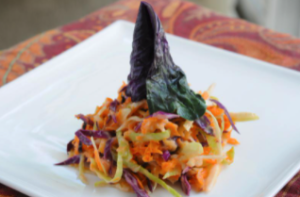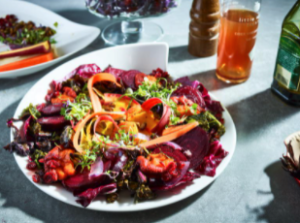Eating in Color: Purple, Part Two
Today marks the last installment of our series: Eating in Color.We have had so much fun with this series. If you missed a post, check out the full collection below...
- Red Strawberries
- Red Bell Peppers
- Orange Oranges
- Orange Carrots
- Yellow Bananas
- Yellow Corn
- Green Kiwi
- Green Kale
- Blue Blueberries
- Blue(ish) Eggplant
- Purple Grapes
And now we'd like to conclude with our last purple food: Purple (aka Red) Cabbage. As you probably already know, "[this] cabbage is, among different vegetables, one of the major sources of anthocyanins" (source). Just half a cup of purple cabbage contains "lots of vitamin C and vitamin K. Cabbage also has vitamin A, fiber, and folate" (source) with loads of additional phytochemicals to boot!When you shop for cabbage, you will usually find it prepared in two ways: whole, or shredded into bags of coleslaw mix. If you're buying a whole cabbage, bring home one that is heavy for its size, with a compact head. Once you get home with your cabbage, put it in the refrigerator, where it will last for about a week. This will give you plenty of time to use it.But how will you use it? Check out the cabbage section of our recipe archive, or try one of my favorite recipes below...
As you probably already know, "[this] cabbage is, among different vegetables, one of the major sources of anthocyanins" (source). Just half a cup of purple cabbage contains "lots of vitamin C and vitamin K. Cabbage also has vitamin A, fiber, and folate" (source) with loads of additional phytochemicals to boot!When you shop for cabbage, you will usually find it prepared in two ways: whole, or shredded into bags of coleslaw mix. If you're buying a whole cabbage, bring home one that is heavy for its size, with a compact head. Once you get home with your cabbage, put it in the refrigerator, where it will last for about a week. This will give you plenty of time to use it.But how will you use it? Check out the cabbage section of our recipe archive, or try one of my favorite recipes below...
- Cole Slaw
- Indian-Inspired Vegetable Fried Rice
- Indigo Beet Salad
- Fish Tacos with Slaw
- Potato Cabbage Casserole
 And, as always, if your clients just aren't into purple cabbage, there are lots of other purple vegetables to try. Why not explore...
And, as always, if your clients just aren't into purple cabbage, there are lots of other purple vegetables to try. Why not explore...
- Purple Cauliflower
- Purple Kale
- Eggplant
- Purple Carrots
- Purple Bell Peppers
- Red Onions
- Purple Potatoes
- Purple Kohlrabi
- Radicchio
- Red Endive
Speaking of exploring, have you visited the Nutrition Education Store lately? Here are a few fun resources to try...




